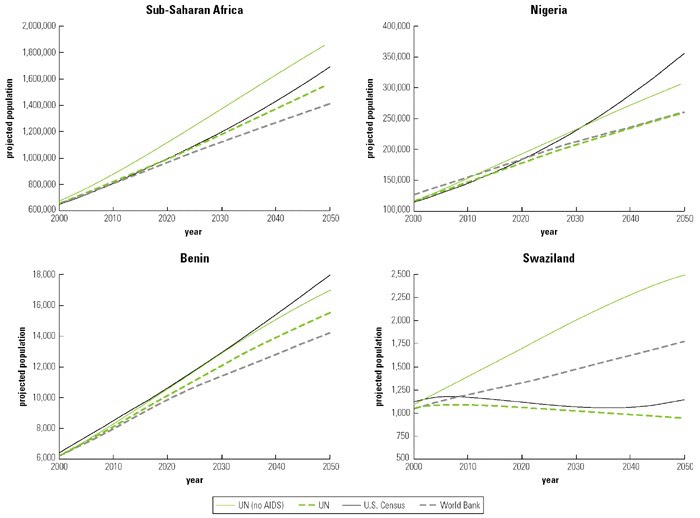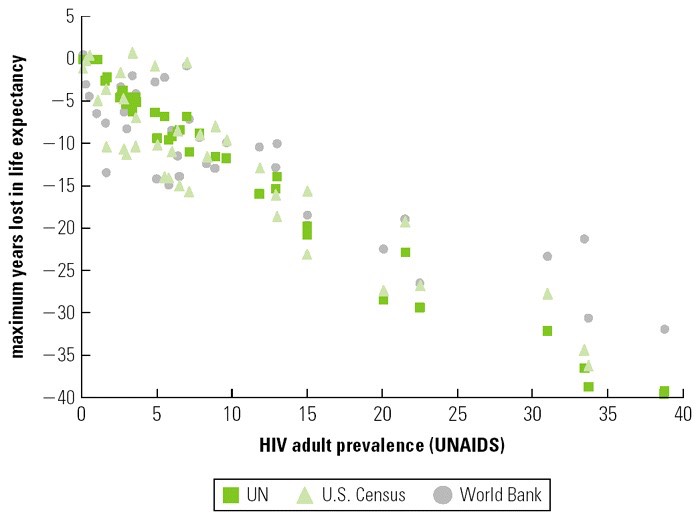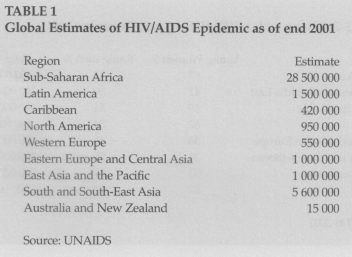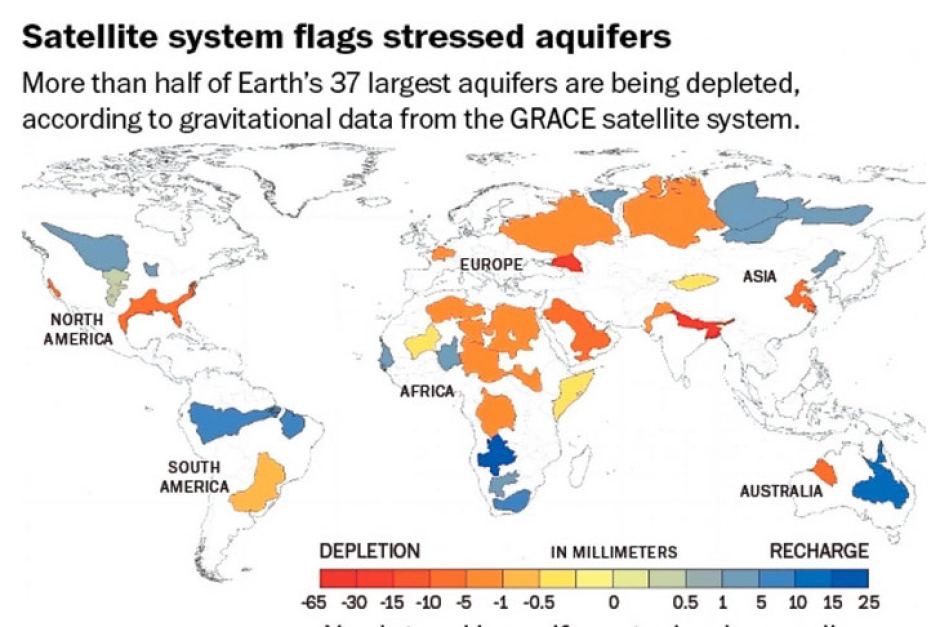Revisiting this topic and its associated sites in 2017 I read that, from a demographic viewpoint the change of population with modernisation is controlled by the relative difference between birth and death rates. There are now four stages:
1. both birth rate and death rate are high [no countries are in that position]
2. death rates drop while birth rates remain high, giving rapid growth [southern Africa]
3. birth rate drops to match the death rate and the population stabilises. [Europe]
However, the article says instead of progressing steadily forward toward stage three as expected, some countries are falling back toward stage one as the historical fall in death rates is reversed, leading the world into a new demographic era. Thus we can add a new stage,
4. The demand for resource in line with stage 3 exceeds what is available and so fails. This forces the population into higher death rates, returning, presumably, that nation to stage 1.
As the 2001 article says: If countries do not break out of the middle stage of the demographic transition in a matter of decades, rapid population growth will eventually overwhelm natural systems, leading to economic decline and forcing societies back into stage one as mortality rises. Over the long term, there is no middle ground. Countries either break out or break down. Unfortunately, a number of countries, mostly in Africa, are showing signs of breaking down. … Although rapid population growth continues in scores of countries, the world is beginning to divide into two parts: one where population growth is slowing as fertility falls, and another where population growth is slowing as mortality rises. One way or the other, population growth will slow.
It seems to me that
(i) a policy of enlightened self-interest might have us dramatically increasing our overseas aid budget with a view to export education very much more effectively, perhaps almost for free. If you didn’t read essay 208 recently then this comment may not make a lot of sense. (ii) that the likely return on such ‘investment’ might generate a different sort of British Empire, one in which we act with a different sort of responsibility and influence. Such export might actually serve to simultaneously fix several other problems we have within Britain.
(iii) that countries who fall into stage 4 above need significant help so as to avoid falling to stage 1 – what is called for is an alternative result, moving from stage 4 to stage 3, the stability of a (reduced) population at a higher standard of living than the other states can accommodate.
The likely factors that would push up the death rate in individual countries presumably include war, disease, starvation and social disintegration. As the article [1] to which I am referring points out, something resulting from population pressure causes the governance to fail (to be overwhelmed). There are now three clearly identifiable threats that
either are already pushing death rates up or have the potential to
do so—the HIV epidemic, aquifer depletion, and land hunger.

See also the (much) later essay 258
That last quote gives an express invitation to explore specifics. I’ll look at those in turn.
This four-part graph is from 2004, source [2].
HIV/AIDS
As source [2] indicates, To add AIDS mortality, a separate projection of HIV/AIDS in the population is necessary. From the size of the infected population and the remaining, susceptible population, the UN estimates the trend in subsequent infections.

The modelling assumes that the perceived or real rise in the death rate will affect the birth rate and pushes the fertility rate up in younger women, say under 35; of course the biological effect of HIV might affect that fertility, but that is not modelled.
More useful is this largely green scatter graph showing the modelling of lost life expectancy with increased prevalence of HIV (and therefore AIDS). I had not realised that the mortality from AIDS is gender-related; more women die. This then has several effects. It is learned that 120 males per 100 females is the point at which some societies become unstable. Back in 2000 some of the Persian Gulf states hit 190 (and were not hit by AIDS). Over time, the effect is a hump (humour?) in the population across an age group, which will subside as that cohort ages. Zimbabwe is predicted to have a sex ratio of 230 (2.3 males per female) in about 2030, for those aged 50-54. In some societies this would represent some sort of social disaster and I do not think it can be passed off as good in any society. A connected concern is called dependency – the fraction of the population that does not work but is dependent upon an earning worker. Thus having the sex ratio rise might be economically advantageous in a society that has low dependency (and some of that forced by the ratio). Where AIDS is prevalent, though the dependency ratio can rise from 50-60 dependants per 100 adults of working age to 70-80 [2 still].
The models for AIDS prevalence are subject to updates. For Kenya, for instance, the UNAIDS estimate of HIV prevalence for 2001 was 15.0, and the current set of projections depend on this estimate. The 2003 estimate fell to 6.7, consistent with DHS results. The 2001 estimate implies that the maximum reduction in life expectancy—relative to the no-AIDS scenario—would be 17.7 years, using the equation in note 2. The 2003 estimate implies a maximum reduction half as large, at 8.7 years.

Looking at the conclusions made by source 2, the effect of HIV/AIDS on sub-Saharan Africa looks likely to cause a 11-13% drop in 2020 population over non-AIDS projections, 10-25% by 2050. Individual countries have far higher ranges, but it should be noted that the model revisions all produce reduced numbers of deaths, which in turn means more people in total. The fertility discussed in essay 208 is indeed affected by AIDS, but the reduction in fertile population is balanced by an increased birth rate as the people strive to replace those lost. It also inevitably increases the motivation to migrate. Source [3], which supplied this table (right), says HIV/AIDS has presented enormous shocks to international development It is considered the world's fourth biggest killer and Africa's leading cause of death. UNAIDS estimates that over 60 million people throughout the world have been infected by the HIV virus since the epidemic began two decades ago.
[3] continues: Among the number of people killed by AIDS in 2001 an estimated 580 thousand were children under the age of 15, and almost 90% were Africans². The implications of HIV/AIDS in Africa are not limited to infection, but also to affecting their entire lives as children. The majority of adults infected by the HIV virus or dying of AIDS are parents of young children. In some cases the children they leave behind were infected at birth or during breast-feeding.
The number of children who have lost one or both parents to HIV-related illnesses in Africa is approximated at 11 million, and it is projected to rise to 20 million by 2010, resulting in the emergence of more vulnerable youths joining the already huge population of unemployed youths³. In the same distressing light, UNFPA established that half of all new infections are among the age group of 15 to 24 years. In its 2003 report, Making One Billion Count: Investing in Adolescence Health and Rights, UNFPA gives an alarming picture for the future. It estimated that a youth is infected with HIV every 14 seconds, with increasingly females accounting for nearly half of HIV infection worldwide, due to biology, gender and cultural norms.
As indicated initially, this sort of disaster moves a nation to demographic states 4 and then 1. When it is not untypical to have lost 20 years of life-expectancy, we must expect that social norms adapt to reflect this situation. Not good for any of us, even those remote from the problem. What we are seeing is decades of progress undone; African countries have been making efforts to reduce their populations for decades through education, family planning and accessibility to contraceptives. If you find population pyramids interesting, look at source [3], para 20. The progress undone leads us to the phrase ‘sustainable development’, what it is that we can do to preserve any parts of the progress – though I am far from certain that we really know what ‘progress’ is, since it seems to simply drive more countries to be the same, surely exaggerating some of the faults instead of exploring variety in a positive way. All social structures are weakened by the pandemic. [Future essay on how it is we measure development, one of those metrics destined to drive nations towards results we then discover were not what we all wanted]. Read source 3 at length to feel informed about this topic.
Aquifer depletion
I have registered that this could become significant in the US (and did so in the 1940s), but, relative to the rest of us, this is a sparsely populated country. Putting that aside for the nonce, aquifer depletion is what happens when water is used up faster than it returns to the aquifer. Indeed, overuse of the aquifer is likely to cause permanent loss, as the emptied space collapses. See [4]. Map below from here.

I suspect this ought to be a separate essay. In the short time I spent looking, I found far too much on American issues and too little on anywhere else. Maybe Essay 114 needs a rewrite?
Land hunger
A new phrase to me, I found an explanation in the Spectator, from which 1960 entry I quote: Any representative government will have to tackle the land hunger which is crippling African economic advance in many of the reserves—a hunger which was one of the principal causes of Mau Mau. It can only do so by redistributing agricultural land. This is repeated in Zimbabwe (source) in the 1980s and the same term is used to describe the cause of the 1905 revolution in Russia. In contemporary times this has taken on a new guise, where whole nations acquire land one way or another as places to grow food. See this from 2012. You might also read some of Olivier de Schutter’s reporting, [6&7]. This raises another issue, to do with self-interest, use of land and rights to the use of land. A little enlightenment and some sensible management would make the overseas purchase of land a success for all concerned, along free trade lines, perhaps.
________________________
In my searching, I found some statements that I felt uncomfortable with. Looking at causes of hunger [8] says Poverty is the principal cause of hunger… Several factors that contribute to hunger and poverty include war and conflict (which displace many refugees), restrictive economic systems, and climate change (which increases food volatility and food prices). Source [8] is well worth a thorough read.
Source [9, 1995] on the other hand, gave me some discomfort in its declaration of myths and facts, but these were to do with context as in essay 230. Such as: The root causes of poverty and hunger are the uprooting of peoples from their land and livelihoods. I was a little less unhappy with the subsequent expansion: For example, population densities on the poor soils of the Chiapas Highlands in Mexico are too high for the local farming economy. But the origin of these population densities goes back to when Mexico was a Spanish colony, and indigenous people were forcibly moved to the Highland area.(5) This forced relocation of such a large number of people onto a small area of marginal land is the root cause of their impoverishment. Today this is one of the poorest regions of Mexico, with rampant malnutrition and diseases of poverty like infant diarrhea [sic], cholera and tuberculosis. Yet nearby parts of Chiapas with very fertile soils [the Grijalva Valley, the Soconusco Mountains, and the coastal plains of the Pacific] have extremely low population densities. These fertile lands are farmed by wealthy and in many cases, absentee landlords, who grow cotton, beef and sugar for export to the U.S., and corn for Mexico City, while the nearby indigenous people continue to go hungry.(6) This pattern of too many people in fragile areas and too few on nearby fertile soils is repeated worldwide. I still disagree with the declarative; I’d be a lot happier with studying what prevented the displaced community from spreading to elsewhere and assigning responsibilities (but not blame) to prevent such from recurrence. We cannot support inefficient food growth simply because it is habit. However, if a different apportionment of land gives us net benefit, then we should do it – as a planet we need more food. I have put the collection of myths and facts in a footnote.
What we do not need, though, is to allow this to be an excuse for letting the population grow even more. We quite definitely need the total population to fall in ways that preserve the demographic state or stage 3 (lower total population, stable population, relatively high living standards). Source [9] again: MYTH: Population control is the answer to hunger and poverty FACT: Only raising the living standards of the poor and increasing the social and economic status of women will end hunger and lower fertility rates.
DJS 20171225
Merry Christmas
[1] http://www.earth-policy.org/images/uploads/book_files/ecoch10.pdf you ought to read this. For 2001 it reads as 2016.
[2] https://www.ncbi.nlm.nih.gov/books/NBK2299/
[3] http://journals.openedition.org/cea/1562
[4] https://www.conserve-energy-future.com/causes-effects-solutions-of-groundwater-depletion.php
[5] https://www.globalpolicy.org/world-hunger/land-ownership-and-hunger.htm
[6] http://www.srfood.org/images/stories/pdf/officialreports/20101021_access-to-land-report_en.pdf
[7] https://www.globalpolicy.org/images/pdfs/NGOWG_on_Food__Hunger/srfood_on_land_grabbing.pdf
[8] http://www.uniteforsight.org/hunger/module2
[9] http://www.hartford-hwp.com/archives/28/079.html
From Source [9], 1995 I continue to disagree with the elevation of opinion to declarative fact. There are many routes to a solution. Each of these pairs could easily form the basis of an undergraduate essay.
MYTH: FACT:
There is simply not enough food to go around
Growing more food will not end hunger: people go hungry even in a world of plenty
There’s not enough food because there are too many people
The root causes of poverty and hunger are the uprooting of peoples from their land and livelihoods
Population control is the answer to hunger and poverty
Only raising the living standards of the poor & increasing the social & economic status of women will end hunger & lower fertility rates
Overpopulation in Third World countries is degrading the environment and provoking massive migration
Expansion of export agriculture is the root cause of much environmental destruction and migration in the Third World
The key to development for the Third World lies in a renewed emphasis on exports and free-trade
Free-trade policies and export agriculture have increased poverty throughout the Third World
Food should be obtained wherever it’s cheapest, even if that means subsidized imports
Third World governments must protect local food production and prioritize the creation of jobs in rural areas
Agrarian reform is passé; where it’s been tried it hasn’t worked
Real agrarian reform is a necessary, but not sufficient, step toward eliminating rural poverty and hunger